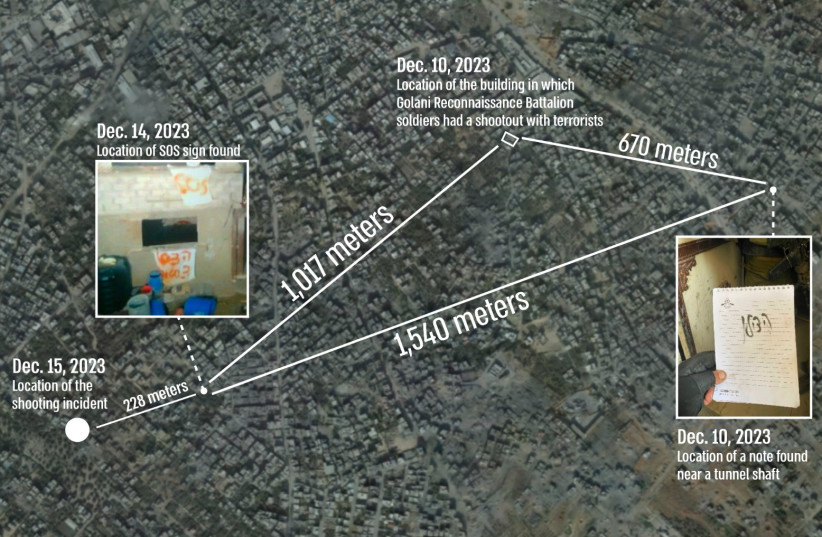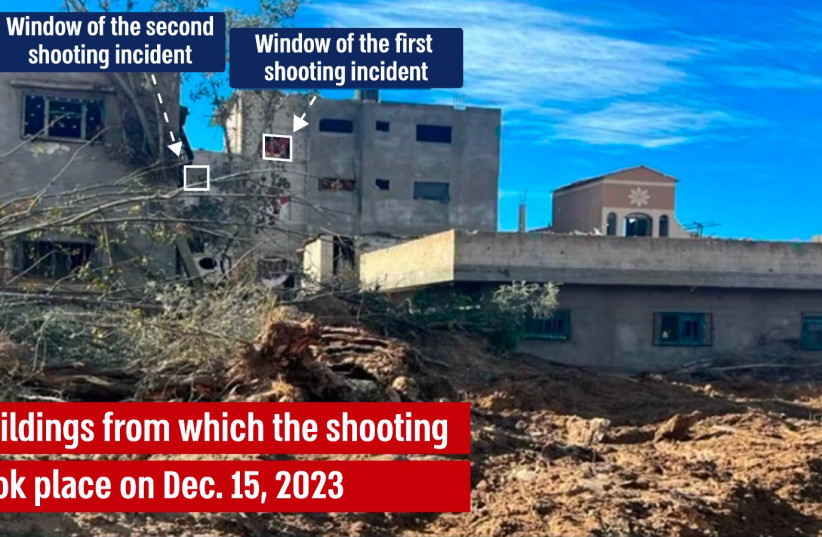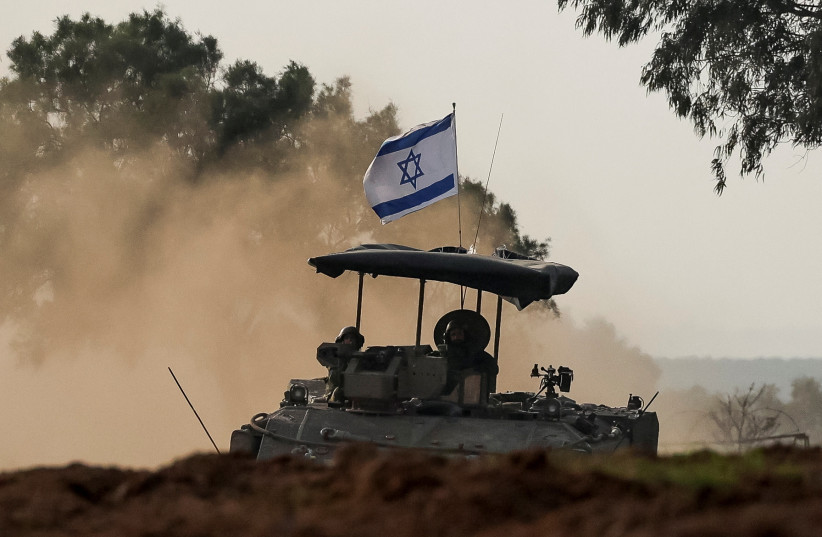The IDF announced on Thursday that it will not take any current action against soldiers who mistakenly killed three Israeli hostages on December 15 who were waving a white flag, screamed “help” in Hebrew, and were bare from the waist up .
The three, named Yotam Chaim, Samer Talalka, and Alon Shamriz, were all taken hostage during Hamas’s October 7 massacre against southern Israeli communities.
In publishing the results of its final probe into the issue, the IDF said that despite the soldiers clearly violating the rules of engagement – by firing on persons who presented no immediate danger and were waving a white flag – the enormous complexity of the circumstances led to no immediate punishment.
Soldiers who killed hostages to remain in Gaza
IDF sources suggested that once the war was over it was possible that disciplinary or other action might theoretically be taken against some of the soldiers involved, but in the meantime the soldiers are being left to continue to fight in the field.
The IDF legal division also technically can second-guess the IDF chief, but that is a very rare occurrence.

Also, with it being ambiguous when the war will be “over,” given discussions of higher and lower intensity stages, it seems that no action will be taken for the foreseeable future.
Already back on December 16, IDF Chief-of-Staff Lt. Gen. Herzi Halevi had signaled this would be the direction he would go in.
Back then he had also said that the soldiers had violated open fire rules, but on the other hand he had not mentioned even removing them from combat without any formal penalty.
Also, at the time the IDF legal division sidestepped addressing the issue, pending the IDF chief’s probe.
But there have been cases where initial evidence was strong enough to launch an initial criminal probe and where the soldiers involved were immediately arrested and questioned under caution - which was not done here.
The incident happened in the Shejaia neighborhood of Gaza City, an area of intense combat where Hamas terrorists have been operating in civilian attire and used complex deception tactics.
Some of those tactics have included trying to use white flags, stuffed animals, or seemingly harmless women to get IDF soldiers to approach an area, where some other terrorists then opens fire or sets off a remote explosive device.
According to the final IDF probe, around six Hamas fighters had been killed or observed recently by IDF forces along the line of travel which the three hostages likely took based on the multiple locations where the IDF has established they definitely spent time.
Some of the Hamas terrorists were killed by infantry, one by a tank, and one by a drone.
All of this information was in the minds of the soldiers involved in killing the three hostages.
Details of the IDF's investigation into the killings
The final probe found that a soldier opened fire while he was one floor up and at a distance of 38 meters from where the hostages were standing outside the ground level of a house.
According to the high command’s understanding of the open fire rules, such a distance and without seeing any weapon, and certainly seeing a white flag and a bare upper body disqualifying the likelihood of explosives, there was no reasonable way to argue the soldier could have felt threatened.

However, the soldier argued that he was given additional instructions from local commanders in the field about what was considered a threat and when to fire, and that approaching and arriving at a distance of only 38 meters and suspicious activity fell within those open fire rules.
Further, given the many fake surrender traps Hamas has set throughout the war, including using Hebrew, white flags, and actual children’s items seized by Hamas in Israel on October 7, Halevi and other commanders seem to be willing to recognize the subjective sense of danger felt by the soldiers involved as valid enough to avoid immediate punishment.
Controversially, the first soldier who opened fire has admitted that he did see the white flag, but still felt it was a trap and that he was in danger.
There is an additional question about whether the second set of soldiers who killed the third hostage in a second round of shooting even after their local commander had issued a cease firing order, may face later repercussions.
However, even these soldiers have argued that they did not hear the cease firing order due to other loud battle noises in the area, which could explain their lenient treatment to date.
There has also been a clear concern from top IDF commanders not to send a message to their forces mid-war which could be viewed as unduly restrictive and endanger their lives when Hamas continues to cynically try to use white flags and other such items for ambushes.
In addition, there have also been over 700 Hamas forces taken into custody, such that it is clear that white flags have worked in numerous cases.
But on the other hand, this is the second recent case where an Israeli with a white flag was mistakenly killed against open fire rules, leaving suspicion that there may be other cases where the rules are being interpreted too aggressively.

On December 15, initially one IDF soldier fired on the three hostages.
Subsequently, the IDF concluded that this initial fire killed two of the hostages, but only wounded the third hostage.
The third hostage ran into a nearby building.
At this stage, the battalion commander called on all IDF forces to cease firing as an operational matter to allow various IDF forces in nearby buildings to exit without being hit by friendly fire.
Some minutes later, the IDF battalion commander called on the wounded third hostage to exit the building again so he could determine whether he was a threat or not. Two different new sets of soldiers other than the original soldier shot him dead.
The entire saga started on December 10 when a different group of IDF soldiers unwittingly freed the hostages during a battle with Hamas terrorists a distance of 1017 meters from where the hostages were killed on December 15.
In the December 10 incident, an IDF dog was sent into a suspicious multistory building in Shejaia.
The IDF dog succeeded in traversing the entry area to the building and ascending from the ground floor to the first floor.
However, when it arrived on the first floor, Hamas forces standing on the second floor shot and killed it. IDF forces realized there were terrorists present and engaged them.
The IDF Golani forces succeeded in killing the Hamas terrorists on the site.
As with some ongoing war situations, since no IDF soldiers were wounded, the Golani forces moved on to attack other Hamas forces in the area and did not immediately come to retrieve the dog.
After-the-fact, it turns out though the dog died, a camera embedded on its body continued to function.
That camera eventually caught footage of the three hostages escaping the area, once they saw that their Hamas guards had been killed.
However, the IDF forces did not get close enough to see them and did not recover the recording until December 16 and did not analyze the recording until December 18.
Hostages called for help amid Gaza fighting
In retrospect, the Golani forces involved believe they heard calls of “Save us” and “Hostages” in Hebrew, but they believed that these were ruses by Hamas to get them to let their guard down since similar ruses have been common during the Gaza War.
The final probe also found that the hostages were standing around 220 meters from a building with the words "help" and "SOS" spray-painted on its exterior walls, which were seen by a drone on December 14. In addition, the IDF drone also found a message saying "three hostages - help," on the buildings around.
Initially, the IDF avoided the buildings with those messages believing that they were Hamas traps because of certain signs on the walls nearby.
